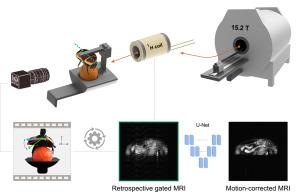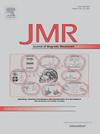残馀运动伪影的去除,使动态μMRI的行为Pachnoda边缘
IF 1.9
3区 化学
Q3 BIOCHEMICAL RESEARCH METHODS
引用次数: 0
摘要
显微磁共振成像,也被称为μMRI,是一种非侵入性的成像方式,非常适合研究小型活模式生物。然而,与行为生物体的生物力学时间尺度相比,μMRI原始数据采集固有的顺序和缓慢,导致图像重建时的运动伪影。最近,我们开发了一种集成的球形跑步机,该跑步机具有前瞻性触发k空间采集技术,为使用μMRI研究活昆虫提供位置一致性。尽管有了这一进展,但在跑步机上活动的昆虫仍然表现出运动伪影,因为系绳运动与内部器官动力学相结合。在这里,我们通过使用从原位计算机视觉系统获得的运动信息开发一个完全回顾性的门控策略,来解决行为昆虫腹部运动的大规模非刚性性质。通过深度学习技术有效地处理门控后持续存在的残余运动伪影。我们训练了一个基于u - net的深度卷积神经网络,使用对模拟的运动损坏和无运动的图像作为监督图像到图像的翻译问题。我们的研究结果表明,将回溯门控μMRI重建与深度学习残余运动补偿技术相结合可以显著减少运动伪影,从而为117 μm平面内分辨率的行为生物的无创动态成像研究铺平了道路。本文章由计算机程序翻译,如有差异,请以英文原文为准。

Residual motion artifact removal enables dynamic μMRI of a behaving Pachnoda marginata
Microscopic magnetic resonance imaging, also referred to as MRI, is a non-invasive imaging modality ideal for studying small live model organisms. However, MRI raw data acquisition is inherently sequential and slow in comparison to the biomechanics timescale of the behaving organism, leading to motion artifacts upon image reconstruction. Recently, we have developed an integrated spherical treadmill with a prospectively triggered k-space acquisition technique to provide position consistency for studying live, behaving insect using MRI. Despite this advancement, behaving insects on the treadmill still exhibited motion artifacts due to tethered locomotion being coupled with internal organ dynamics. Here, we are addressing the large-scale non-rigid nature of the abdominal motion of the behaving insect by developing a fully retrospective gating strategy using the motion information obtained from an in-situ computer vision system. Residual motion artifacts persisting after gating are effectively managed through a deep learning technique. We trained a U-Net-based deep convolutional neural network using pairs of simulated motion-corrupted and motion-free images as a supervised image-to-image translation problem. Our results demonstrate that combining retrospective gated MRI reconstruction with a deep learning residual motion compensation technique can significantly reduce the motional artifacts, thereby paving the way for the non-invasive dynamic imaging studies of behaving organisms with 117 m in-plane resolution.
求助全文
通过发布文献求助,成功后即可免费获取论文全文。
去求助
来源期刊
CiteScore
3.80
自引率
13.60%
发文量
150
审稿时长
69 days
期刊介绍:
The Journal of Magnetic Resonance presents original technical and scientific papers in all aspects of magnetic resonance, including nuclear magnetic resonance spectroscopy (NMR) of solids and liquids, electron spin/paramagnetic resonance (EPR), in vivo magnetic resonance imaging (MRI) and spectroscopy (MRS), nuclear quadrupole resonance (NQR) and magnetic resonance phenomena at nearly zero fields or in combination with optics. The Journal''s main aims include deepening the physical principles underlying all these spectroscopies, publishing significant theoretical and experimental results leading to spectral and spatial progress in these areas, and opening new MR-based applications in chemistry, biology and medicine. The Journal also seeks descriptions of novel apparatuses, new experimental protocols, and new procedures of data analysis and interpretation - including computational and quantum-mechanical methods - capable of advancing MR spectroscopy and imaging.

 求助内容:
求助内容: 应助结果提醒方式:
应助结果提醒方式:


